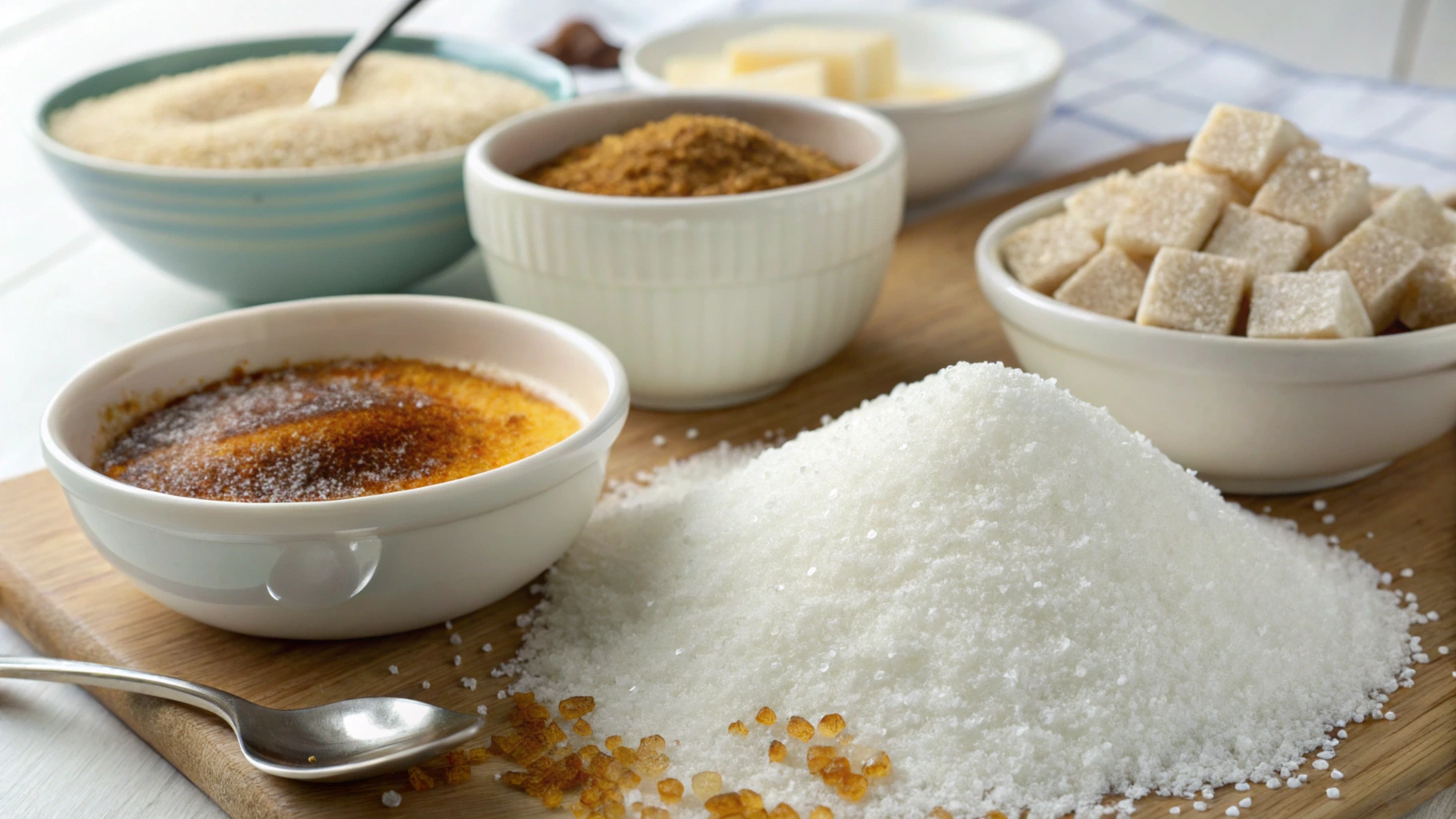Crème brûlée, a quintessential French dessert, is revered for its delicate custard base and signature caramelized sugar topping. Achieving the perfect crème brûlée goes beyond just mastering the custard; the sugar you choose plays a crucial role in creating that flawless crackly top. In this article, we explore the best sugar for crème brûlée and compare various types of sugar based on their ability to create the perfect caramelized crust. Whether you are a beginner or a seasoned dessert enthusiast, in any case, understanding the science behind sugar selection and caramelization is crucial and can undoubtedly elevate your crème brûlée game.
Understanding Sugar Types for Crème Brûlée
To choose the best sugar for crème brûlée, it’s important to understand the different types of sugar available. Each type of sugar has unique properties that affect its flavor, texture, and caramelization potential. The most commonly used sugars for this dessert include white granulated sugar, brown sugar, Demerara sugar, and Turbinado sugar. Each of these options contributes to the crust in distinct ways.
Best Sugar for Crème Brûlée: White Granulated Sugar
White granulated sugar is the most popular choice for crème brûlée, and for good reason. This sugar has a fine texture with small, uniform crystals that dissolve easily into the custard, ensuring a smooth and creamy base. When it comes time to torch the sugar on top, white granulated sugar performs exceptionally well. It melts quickly and evenly, forming a perfect amber-colored, brittle crust.
The neutral flavor of white sugar also allows the rich custard—made from cream, egg yolks, and vanilla—to remain the star of the show. It doesn’t overpower the flavor of the custard, making it an ideal choice for classic crème brûlée recipes. Additionally, white granulated sugar is readily available, affordable, and consistent, which further solidifies its status as the go-to sugar for crème brûlée.
Pros:
- Dissolves easily into the custard.
- Forms an even, amber-colored caramelized crust.
- Neutral flavor that allows the custard’s flavors to shine.
- Easy to use and widely available.
Cons:
- May lack the depth of flavor that some alternative sugars provide.
Best Sugar for Crème Brûlée: Brown Sugar
Brown sugar is another option worth considering when making crème brûlée. Unlike white granulated sugar, brown sugar contains molasses, which gives it a darker color and a slightly richer, more caramel-like flavor. This flavor profile can complement the creamy custard, adding a touch of warmth and depth.
However, brown sugar’s higher moisture content can be problematic when it comes to caramelization. The added moisture can prevent the sugar from melting evenly, resulting in a softer, less crisp crust. Additionally, brown sugar has a tendency to burn more quickly under the heat of a kitchen torch, making it challenging to achieve the perfect, golden-brown crust without careful attention.
For a twist on traditional crème brûlée, brown sugar can be used to add complexity and depth of flavor. However, it is typically not the best choice if a perfectly crisp, smooth top is desired.
Pros:
- Rich, caramel-like flavor due to molasses content.
- Can add complexity to the flavor of the custard.
Cons:
- Higher moisture content can prevent proper caramelization.
- Burns more quickly and can lead to an uneven crust.
Best Sugar for Crème Brûlée: Demerara Sugar
Demerara sugar is a type of raw sugar that has large, golden-brown crystals. Its coarse texture and distinct toffee-like flavor can add a robust sweetness to the crème brûlée’s top layer. When caramelized, Demerara sugar creates a thick, crunchy crust that contrasts beautifully with the creamy custard beneath.
However, because of its large crystals, Demerara sugar doesn’t melt as easily as white sugar. This can result in an uneven caramelization process, especially if the sugar is not torched carefully. The larger crystals can also lead to a slightly gritty texture if not fully melted, so a steady hand and attention to detail are required when using Demerara sugar.
Many chefs recommend mixing Demerara with white granulated sugar to balance out the melting speed and achieve the perfect texture. Demerara sugar can be a great choice for those who enjoy a thicker, more textured crust with deeper caramel notes.
Pros:
- Adds a rich toffee-like sweetness.
- Creates a thicker, crunchy caramelized crust.
Cons:
- Larger crystals can result in uneven melting.
- Can lead to a gritty texture if not melted thoroughly.
Best Sugar for Crème Brûlée: Turbinado Sugar
Turbinado sugar is another raw sugar that has slightly smaller crystals than Demerara but still retains a similar molasses flavor. It is lightly processed, which helps preserve some of the natural molasses, giving it a slightly earthy, caramel flavor.
When used for crème brûlée, Turbinado sugar creates a crunchy, slightly thicker caramelized top, similar to Demerara. However, it tends to melt more slowly, requiring more time and patience to achieve the perfect crust. To ensure even caramelization, many bakers recommend combining Turbinado sugar with a finer sugar, such as white granulated sugar.
Like Demerara, Turbinado sugar works well for those looking to add an extra layer of flavor to their crème brûlée but may require some experimentation to get the perfect caramelization.
Pros:
- Adds a mild, earthy caramel flavor.
- Creates a thick, crunchy caramelized crust.
Cons:
- Melts slowly, requiring patience and careful torching.
- May need to be blended with a finer sugar for even results.
The Science of Caramelization
Caramelization is a crucial process in making crème brûlée, as it determines the texture and flavor of the sugar crust. When sugar is exposed to heat, it undergoes a series of chemical reactions that break down its molecules, leading to the formation of new compounds that produce rich, golden-brown colors and deep, complex flavors. The caramelization process typically starts at around 320°F (160°C) and continues until the sugar reaches the desired amber hue.
The type of sugar used will influence the final result. White granulated sugar caramelizes quickly and evenly, whereas raw sugars like Demerara and Turbinado take longer to melt, resulting in a thicker, crunchier crust. In addition, the slower melting process of raw sugars can lead to a more complex, deeper flavor, making them a great option for those looking to experiment. However, due to their larger crystals, they may require a bit more patience and care to achieve the perfect caramelization. Ultimately, the choice between white granulated sugar and raw sugars depends on the texture and flavor profile you prefer for your crème brûlée.. Understanding how different sugars react to heat is essential to mastering the crème brûlée caramelization process.
Tips for Perfect Caramelization
Achieving the perfect sugar crust is all about technique. Here are some helpful tips to ensure your crème brûlée turns out just right:
- Use a Kitchen Torch: A kitchen torch provides controlled heat and allows you to caramelize the sugar evenly without overheating the custard underneath.
- Apply Sugar Evenly: Sprinkle a thin, uniform layer of sugar on top of the custard. Too much sugar can lead to uneven melting and burning.
- Choose the Right Sugar: For a smooth, even crust, white granulated sugar is the best choice. If using raw sugars like Demerara or Turbinado, be sure to blend them with finer sugar for better results.
- Control the Distance: Hold the torch a few inches away from the surface and move it in circular motions to ensure even melting.
Common Mistakes to Avoid
When making crème brûlée, it’s easy to make mistakes that can ruin the perfect caramelized crust. Here are a few common errors to avoid:
- Using Wet Sugar: Wet or damp sugar won’t melt properly and can cause uneven caramelization.
- Applying Too Much Sugar: A thick layer of sugar can melt unevenly, leading to burnt spots or an overly thick crust.
- Over-Torching: If the torch is held too long in one spot, the sugar can burn and develop a bitter flavor. Always keep the torch moving.
Alternative Sugars for a Creative Twist
For those looking to experiment, alternative sugars can offer unique flavors and textures for crème brûlée. Here are some creative options:
- Coconut Sugar: This sugar, derived from the sap of coconut trees, has a subtle tropical flavor and is less refined than white sugar.
- Maple Sugar: Made by evaporating maple syrup, maple sugar provides a rich, smoky sweetness that can complement the creamy custard.
- Muscovado Sugar: This dark, unrefined sugar has a strong molasses flavor and is perfect for those who enjoy rich, deep flavors in their desserts.
Health Considerations
While sugar is an essential ingredient in crème brûlée, it’s important to be mindful of its nutritional content. Excessive sugar consumption can lead to health issues such as weight gain and increased risk of chronic diseases. Opting for less-refined sugars, like Turbinado or coconut sugar, can offer trace minerals and a slightly lower glycemic index, making them a more health-conscious choice. However, moderation is key, as these alternatives still contain sugar.
Expert Opinions
Professional chefs typically recommend white granulated sugar for achieving a classic crème brûlée. Its fine texture and even caramelization make it the best choice for beginners and experienced cooks alike. However, many chefs encourage experimenting with blending sugars, such as mixing white sugar with Demerara or Turbinado, to create a more complex flavor profile and unique texture.
The key, according to culinary experts, is mastering the torching technique. A steady hand, patience, and an understanding of sugar chemistry are all essential for perfecting the crème brûlée crust.
Frequently Asked Questions
What is the base of crème brûlée? Crème brûlée is made from a rich custard base consisting of heavy cream, egg yolks, sugar, and vanilla. The custard is gently baked in a water bath to achieve a smooth, velvety texture.
How do I avoid ruining my crème brûlée? To avoid ruining your crème brûlée, ensure the custard is cooked gently and evenly, and avoid over-torching the sugar. Use the best sugar for crème brûlée, like white granulated sugar, and apply it in a thin, even layer for the best results.
What can I serve with crème brûlée? Crème brûlée pairs wonderfully with fresh berries, fruit compotes, shortbread cookies, or a dollop of whipped cream. These accompaniments add contrast and texture, enhancing the overall dessert experience.
What sugar should I use for crème brûlée? White granulated sugar is the best choice for most classic crème brûlée recipes due to its smooth texture and even caramelization. If you’re looking for something more adventurous, try blending it with Demerara or Turbinado for added flavor and texture.
Conclusion
After exploring the various types of sugar, it’s clear that white granulated sugar is the best option for achieving the perfect crème brûlée. Its fine texture, neutral flavor, and even caramelization make it the top choice for creating a smooth, crackly, and golden-brown sugar crust. However, experimenting with alternatives like Demerara or Turbinado sugar can add depth and complexity to your dessert. Ultimately, the best sugar for crème brûlée comes down to personal preference and the type of flavor and texture you want to achieve. Choose your sugar wisely, and enjoy creating a delicious, perfectly caramelized crème brûlée every time!
For a delightful twist on classic desserts, check out this Ultimate Slutty Brownie Recipe, which combines rich layers of cookie dough, brownie batter, and Oreo cookies for a decadent treat.
If you’re looking to experiment further with your dessert repertoire, consider trying this delicious Crab Brûlée Recipe for a savory take on the traditional crème brûlée.

